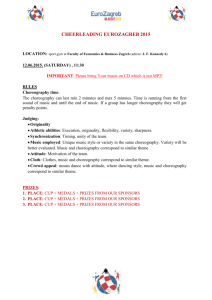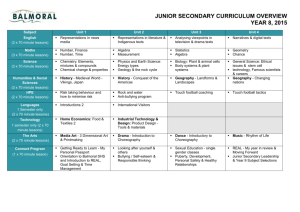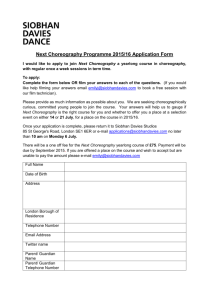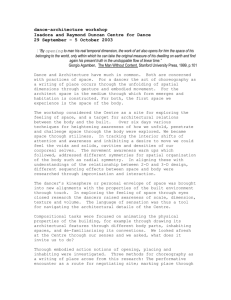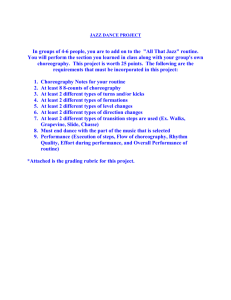Choreography: A Pattern Language Michael Klien, 2007
advertisement
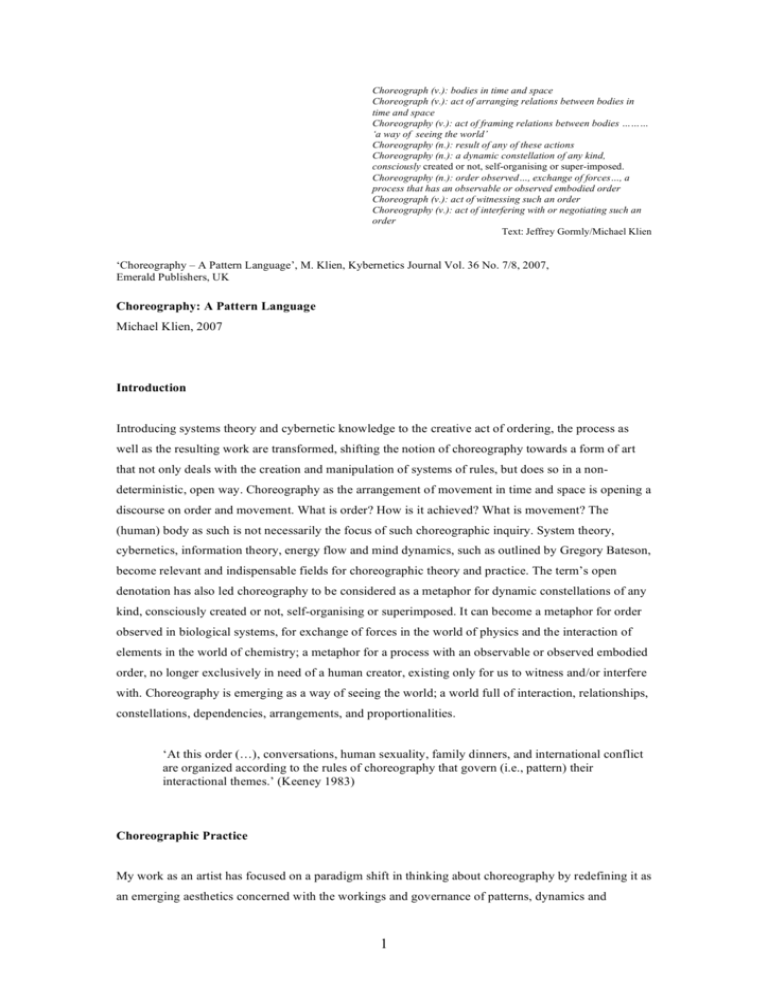
Choreograph (v.): bodies in time and space
Choreograph (v.): act of arranging relations between bodies in
time and space
Choreography (v.): act of framing relations between bodies ………
‘a way of seeing the world’
Choreography (n.): result of any of these actions
Choreography (n.): a dynamic constellation of any kind,
consciously created or not, self-organising or super-imposed.
Choreography (n.): order observed…, exchange of forces…, a
process that has an observable or observed embodied order
Choreograph (v.): act of witnessing such an order
Choreography (v.): act of interfering with or negotiating such an
order
Text: Jeffrey Gormly/Michael Klien
‘Choreography – A Pattern Language’, M. Klien, Kybernetics Journal Vol. 36 No. 7/8, 2007,
Emerald Publishers, UK
Choreography: A Pattern Language
Michael Klien, 2007
Introduction
Introducing systems theory and cybernetic knowledge to the creative act of ordering, the process as
well as the resulting work are transformed, shifting the notion of choreography towards a form of art
that not only deals with the creation and manipulation of systems of rules, but does so in a nondeterministic, open way. Choreography as the arrangement of movement in time and space is opening a
discourse on order and movement. What is order? How is it achieved? What is movement? The
(human) body as such is not necessarily the focus of such choreographic inquiry. System theory,
cybernetics, information theory, energy flow and mind dynamics, such as outlined by Gregory Bateson,
become relevant and indispensable fields for choreographic theory and practice. The term’s open
denotation has also led choreography to be considered as a metaphor for dynamic constellations of any
kind, consciously created or not, self-organising or superimposed. It can become a metaphor for order
observed in biological systems, for exchange of forces in the world of physics and the interaction of
elements in the world of chemistry; a metaphor for a process with an observable or observed embodied
order, no longer exclusively in need of a human creator, existing only for us to witness and/or interfere
with. Choreography is emerging as a way of seeing the world; a world full of interaction, relationships,
constellations, dependencies, arrangements, and proportionalities.
‘At this order (…), conversations, human sexuality, family dinners, and international conflict
are organized according to the rules of choreography that govern (i.e., pattern) their
interactional themes.’ (Keeney 1983)
Choreographic Practice
My work as an artist has focused on a paradigm shift in thinking about choreography by redefining it as
an emerging aesthetics concerned with the workings and governance of patterns, dynamics and
1
ecologies. Choreography has been proposed as a ‘pattern language’, an emerging, autonomous
aesthetic discipline, the findings of which can be applied to other spheres of human endeavours, such
as the social realm. For the past ten years fellow artists [1] and myself have been working towards the
formulation of this ‘aesthetics of change’. During this period we have considerably redeveloped the
conventional concepts of choreography, opening up the discipline to other fields of human knowledge.
Integral to this development have been the writings of Gregory Bateson, or more over, his way of
seeing the world. Bateson’s ideas, coupled with developments in contemporary art, present a
fundamental shift in thinking about choreography: away from the act of structuring and arranging
information in time and space, superimposing order onto a seemingly inactive and passive world,
towards a recognition of interconnectedness: the creative act of setting the conditions for things to
happen, the choreographer as the navigator, negotiator and architect of a fluid environment that he/she
himself/herself is part of. I suggest that Bateson’s descriptions, insights and readings of nature form the
basis for choreography to emerge as an aesthetics of change. It is difficult to trace or pinpoint
Bateson’s influence on this process, but his ideas have constantly been inspiring and challenging,
providing long-lost bridges between the worlds of numbers, straight lines, cause-and-effect and the
worlds of poetry, dreams, quantities and recursivity, thereby manifesting a more substantive and richer
world of patterns. Reading Bateson harnesses a new way of thinking, and although the processes of
research and development in our field will not always relate to Bateson’s ideas directly, the underlying
patterns of thought are very similar. Once absorbed his timeless and thorough interpretation of nature
effortlessly destabilises established frameworks running throughout human civilisation. His
observations expose exploitative world-views, ignorance and compartmentalised linear thinking - much
of which human creation is based upon. Once understanding Bateson, one can no longer speak of
discreet realities, as reality is woven through and in between different speech and in between different
modalities of presentation. Bateson’s forms of double-description make apparent a reality that cannot
be spoken about directly. His work lays bare a world of unfathomable complexity, a reality of relations
not to be captured in the logic of language.
Traditional approaches to choreography are based on the idea of dance being 'the use of energy in
space and time' (Ellfeldt 1974), suggesting that choreography is the arrangement of this energy in space
and time. My work as a choreographer started out by subscribing to dominant ordering procedures,
whereby A is followed by B, B by C, etc. Each work has a distinct beginning, middle and end, and all
movement is (relatively) fixed within space and time. The way our society has choreographed dance
has always been reflective of the larger phenomena of how we, as a society, deal with the unknown, the
unframeable, the spiritual and the animal. Conventional choreography imposes rigid frames upon
dance. It is the embodiment of cultural suppression of that what is not to be governed by subjective and
collective will.
In the late 90’s I became dissatisfied with the fixed nature of my work and I followed various leads,
including Bateson’s, to establish choreographic procedures of active ordering and steering that would
be closer to the way nature works. ‘Duplex’ – a pas des deux for Ballett Frankfurt [2] was created for
dancers to play out a duet every time anew. A pas de Deux, that with the help of a computer software
2
allowed to maintain its movement-proportionalities in terms of its compositional structure. I aimed to
loosen up rigid compositional structures (such like a Pas de Deux), whilst maintaining a specific,
overall Gestalt or form. The central question that arose was how to keep this overall Gestalt whilst
keeping the substance, or the narrative of the piece -even in its abstract nature- quite fluid. ‘Duplex’
tried to preserve immediacy and the moment of creation while at the same time providing a structural
skeleton of relations for the whole piece not to fall apart. The dancers took instructions from screens
around the stage that constantly provided them with information to be translated into movement. The
script was running past them like a music score. It took about a year to get comfortable with this
procedure but at the point of the premiere the reading-off and integration into performance was rather
effortless. The complex and problematic elements were the lifts and physical contacts between the
dancers because it required them to read it off and interpret the information the same way, otherwise it
would cause confusion or create a certain conflict. It soon became apparent that these moments were
actually the very interesting elements of ‘Duplex’. In this work the dancers had to continuously be in
the moment, forming strategies in regards to the other and in regards to exact timing and spacing; all of
which required an active, present mind. Over and over situations arose that caused conflicts. These
circumstances helped to developed little stories within the piece that were not preconceived and very
much emerged in the moment. The work became most interesting when the dancers adapted the
movement material to their own needs. ‘Duplex’ allowed very personal elements to arise ; the
performers weren’t just ‘dancers’ in a conventional sense but ‘real people’, living their lives on stage,
and because of the compositional methods applied, these elements became very vivid. Since then I am
much more focused on collaborating with dancers as artists rather than working with ‘bodies’.
Conventional approaches to choreography often utilise dancers to create pattern that are not directly
relevant to the individual (the dancer) forming the pattern. As I am aiming to work with the whole
person all the movement material within a work is generated out of his/her own processes such as
his/her memory and his/her ability to learn and to forget. The final choreographies cannot be rehearsed
because all processes of learning and creation are encoded within the choreographic (compositional)
structure of the piece. Therefore, the piece, once it is set, can only be run once or twice a day, till it
reaches a critical state through the various processes of individual learning and integration. At some
stage an overall compositional Gestalt arises that is stable enough to be performed as ‘a piece’ in front
of people. The challenge in such work is to work with the individuals as an artist, to bring their
memories, experiences, physical knowledge, moods etc into the creative process, giving space for such
processes to be recalled and developed within the work. The choreographic framing has to happen for
the whole individual – including their thoughts and memories. This leads to issues of ‘steering’ and
group-dynamics as the act of choreography takes political dimensions. The dancers are no longer
‘employed to perform’, but they are taking part in ‘living on stage’, negotiating their personal freedom
and subjective reality within a larger group. The choreographer is no longer concerned with the
creation of particular patterns or instances, but is providing conditions for things to happen. To remove
the stage from this equation is really a small step from this particular approach, and choreography can
be utilised as the creative act of composing fluid architectures of mental frames for living. The term
‘social choreography’ has been emerging out of this work to replace the concept of ‘social
3
engineering’, moving the notion of steering and ordering a larger system away from mechanical
thinking into the realm of creativity and aesthetics.
4
Perception And The Subversive Act Of Ordering
Creation and perception are tightly entangled. Ananda Coomaraswamy wrote that ‘art is to imitate
nature in its manner of operation.’ (Coomaraswamy 1934), suggesting that the artist utilises processes
deductible from a reality as perceived by the subject to formulate structural methodologies, rather than
simply imitating nature’s appearance. Compositional/creational tools are ‘learned’ dynamics and
processes, with some tools – such as repetition - having their basis in an observed biological world.
The simple structural tool of ‘repetition’ as commonly used by composers and choreographers, is
deeply embodied in the repetitive cycles of day and night, ebb and flow and the calendar’s seasons. It is
from our environment that we deduct our structural processes to employ them for our own means,
whether to write music, choreograph dances or build nations. I am inclined to extend this statement to
all forms of artificial human creation, hence from the construction of artefacts to the creations of tools,
companies, contracts and conditions for the creators and their families to live-in. All perceived patterns
that have been assimilated into our knowledge are recursively connected to all the patterns we have at
our disposal for any conscious act of creation. It often seems that we are limited foremost not by
imagination, but by perception and the lack of ability to integrate the perceived into our thought
processes. Personally, I believe that the way we organise our pots and pans has a direct implication on
the way we organise our children and our relationships in general. However, it is hardly the pots that
determine the order of our world directly, but a deeper, imprinted unconscious order, which governs
humanity, society and the individual.
A crude reading of nature (hierarchical, compartmentalised-thinking, etc.) leads to a limited repertoire
of patterns from which to create conditions for living, as people are set in, and by one another, in
certain relations. The resulting creations, the artificial organisational constructs, are recursively
validating each other, creating subtle balances - the very assumptions on which our collective reality is
built upon. As long as in one’s perception of reality cause and effect is tightly linked and easily
separable from its context, the only viable option for building physical and mental structures is to
follow a linear path, whereby a substance of some sort is fixed within a compositional structure of
beginning, middle and end. The resulting assumptions in turn form gaps and holes in the rhizome of
relations, a kind of negative space that forms a mould for other structures to fill, thereby creating
attractors or force fields in the fabric of relations. These once over cause ideas to develop into certain
structural/relational patterns or shapes which recursively form the fluid matrix of life. Artificial
constructs and creations are intertwined with organisational dynamics not part of conscious creation
but bound into much wider processes of self-organisation, emergence, learning and evolution. To what
degree human creation is no more than a myth subject to much larger forces at play remains
unanswered. However, a notion of change subject to human consciousness clearly remains in one’s
experience. To change the way things are done – the way things are – one must thrust a deeply
subversive act into the existing language of patterning, introducing a new structural vocabulary to the
fabric of relations. By utilising new compositional and organisational procedures, some of which might
remain non-verbalised, the very assumption of reality is questioned in the larger system of artificial
5
creation as the “idea-moulds” of how things are will change – and once more, a slightly re-configured
reality might emerge through a recursive process carried through the larger system. Just like a virus
can affect the whole system through the system’s ability to adjust to a newly found internal challenge,
so new ways of patterning can and will generate major change in the overall system. However, newly
discovered patterning procedures can only be found within the larger framework of which one is a part.
This awareness should evoke a renaissance in the examination of the fundamental forces at work in
nature, harnessing these forces by abstraction, adjusting and refining them, thereby introducing new
elements, as well as changing the collective repertoire of ordering, structuring and hence creation.
Bateson’s Manner
As outlined above, ‘(…) to imitate nature in its manner of operation’ (Coomaraswamy 1934), one has
to cultivate a sensibility for exactly what this manner is. Gregory Bateson was able to harness a deeply
developed sensibility for the interconnectedness and interdependence of living systems thereby
enabling new ways of structuring, ordering and creating to emerge.
‘One of the interesting things that happens if you look at your hand and consider it not as a
number of bananas at the end of a sort of a flexible stick but as a nest of relations out there
(…) you will find that the object looks much prettier than you thought it looked. A part of the
discovery of the beauty of the biological form is the discovery that in fact it is it put together
of relations and not put together of parts. This means with a correction of our epistemology
you might find the world was a great deal more beautiful than you thought that it was. Or
might let in that fact of its being beauty, in a way that you were able of keeping it out by
thinking that the world was made up of parts and wholes. {…] Relations between relations
and relations between relations’ relations. (sic.)
(Bateson, G., audio recording, 1979)
To live harmoniously within an ecological system, one must strive to perceive the deep structural
processes from one’s environment, harvest them, integrate and digest them, to make them part of one’s
mental processes and furthermore to apply them as structural tools in one’s personal creations.
Bateson’s notion of ‘mind’ provides a foundation for the perception of a world rich in patterns, of a
choreographic fabric of life, of a world, which thinks and dances. Rather than looking at mind and
matter as discreet substances, Bateson discusses ‘mind’ according to a particular organisational
process: the arrangement of matter. Patterns of organisation and relational symmetry evident in all
living systems are indicative of this particular understanding of ‘mind’. In Bateson’s view, all of the
following criteria have to be satisfied before a system can display phenomena like thought, evolution,
life, and learning; phenomena which are part of open or living systems.
1)
2)
3)
4)
5)
A mind is an aggregate of interacting parts or components
The interaction between parts of mind is triggered by difference, and difference is a non-substantial
phenomenon not located in space or time; difference is related to negentropy and entropy rather than to energy
Mental process requires collateral energy
Mental process requires circular (or more complex) chains of determination.
In mental process, the effects of difference are to be regarded as transforms (i.e., coded versions) of events
which preceded them. The rules of such transformation must be comparatively stable (i.e. more stable than the
content) but are themselves subject to transformation.
6
6)
The description and classification of the processes of transformation disclose a hierarchy of logical types
immanent in the phenomena.
(Bateson 2002)
These six points provide the foundation upon which an entirely new aesthetics can be built. They form
a simple, but precise description, of how life holds together, forms bodies, ideas, even social systems.
Bateson’s thought manifests an awareness of a new reality, whereby a choreographer’s act of creation
can no longer blindly accept the boundaries of tradition and habit, but must instead, pursue patterns of
thought in which relations form a mind. He or she must show a healthy disregard for distinctions
generated by conventional modes of human thought and be prepared to re-organise reality around the
manner in which nature works, in the form of “ecologies of mind”. Bateson’s world, once assimilated,
shakes existing boundaries, distinctions, hierarchies, habits, and ordering principles to the core. If we
as human beings could manage to somehow integrate such sensitive knowledge into our work and life,
new, more suitable patterns of living and consuming would emerge. Being closer to the way nature
works, these new patterns would create less potential for conflict with the environment and most likely
extend “the wave” called humanity.
Summary
Choreography has become a metaphor for dynamic constellations of any kind, consciously
choreographed or not, self-organising or artificially constructed. It has become a metaphor for order,
intrinsically embodied by self-organising systems as observed in the biological world or superimposed
by a human creator. If the world is approached as a reality constructed of interactions, relationships,
constellations and proportionalities and choreography is seen as the aesthetic practice of setting those
relations – or setting the conditions for those relations to emerge – choreographic knowledge gained in
the field of dance or harvested from perceived patterns in nature should be transferable to other realms
of life. The choreographer, at the centre of his art, deals with patterns and frameworks within the
context of an existing, larger, ongoing choreography of physical, mental, and social structures. As an
aesthetics - a sensitive knowing – of change, the discipline of choreography can be applied to enquire
into the dance of life, effortlessly merging observation, theoretical writing and philosophy with
practical rigor and personal expression to create works of art. The stage becomes a laboratory, the
laboratory a stage for the governing and steering of existing mind-dynamics and processes, whether
physically expressed (such as the body or a flower) or not (such as evolution or learning). Applying the
aesthetics of choreography as a purposeful, creative and proactive tool upon the surface of
consciousness, proves a healthy disregard to virtual boundaries of human knowledge production which
have arisen through habit or otherwise, transgressing through realms known as sociology, philosophy,
psychology, religion, biology and history. This approach engages everyone’s perception and
knowledge of ‘how things move’, inquiring if and how individuals can imaginatively order and reorder aspects of their personal, social, cultural and political life. It examines the role of the
choreographer as possible agent of change within an ever-changing environment.
7
Afterthought
Last year as I sat and prepared for a symposium on Choreography as an Aesthetics of Change, I tried
to formulate a worldview that I had been thinking about. How everything is connected and organised
according to certain patterns, patterns that constitute a mind… just as Bateson had described it. It
became clear that to find sanity in this universal mind we first and foremost need to find an ecology
within. Once we have developed a sensibility for all of that, we ought to find steps to such an ecology of
mind - I was convinced I had finally figured it all out whilst my eyes drifted to my left, focusing in on
one of Bateson’s books (Steps to an Ecology of Mind), recognising that I finally (might have)
understood the title.
8
Reference list
Bateson, G., (2000), Steps to an Ecology of Mind, London: The University of Chicago Press, Ltd
(2002), Mind and Nature, Hampton PR
(1979) What is Epistemology? Audio Recording, Gregory Bateson Lecture, Esalen:
Big Sur Tapes
Bertalanffy, L. (1969), General System Theory, New York: George Braziller Inc.
Coomaraswamy, A., (1934), The Transformation of Nature in Art, Cambridge: Harvard University
Press
Ellfeldt, L., (1974), A Primer for Choreographers: An Introduction to Modern Dance Composition,
London: Dance Books
Keeney, B., (1983), Aesthetics of Change, New York: Guildford Press
Footnotes
[1] The core of this research has been taking place at Daghdha Dance Company (Limerick, from 2003
onwards), Ballett Frankfurt and Barriedale Operahouse (London, 1994-2000). Artists involved in the
formulation of choreography as an aesthetics of change include Jeffrey Gormly, Michael Klien,
Nicholas Mortimore, Davide Terlingo and Steve Valk amongst others.
[2] ‘Duplex’ has been produced by Ballett Frankfurt in 2001.
Concept/Choreography: Michael Klien Music: Volkmar Klien; Programming: Nick Rothwell
9
